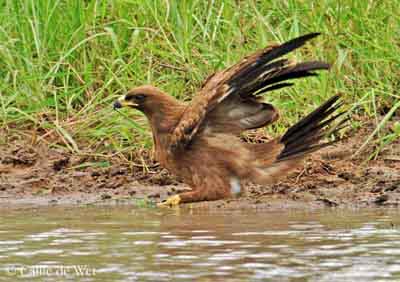
Tawny Eagle
Aquila rapax
Accipitriforme Order – Accipitridae Family
BIOMETRICS:
Length: 65-75 cm ; Wingspan: 170-190 cm ; Weight: 1700-3050 g
LONGEVITY : up to 45 years
DESCRIPTION:
Tawny Eagle is similar to Steppe Eagle (Aquila nipalensis), but smaller and paler. There are individual variations in plumage colours and dimensions of spots and marks.

Adult has variable colour on body and head. In South Africa, most of Tawny Eagles are reddish-brown; some of them are dark brown, with variably streaked dark underparts. Upper great coverts and flight feathers are brown, contrasting with rufous plumage. Tail is long and slightly rounded. Flight feathers lower edges are greyish, finely barred with dark brown. We can see a white pattern under primaries.
Bill is dark grey and yellow, commissures are yellow, extending until middle-eye level. Eyes are yellow-amber. Legs are covered with reddish-brown feathers, talons are yellow.
Female is generally darker, and much more speckled than male.
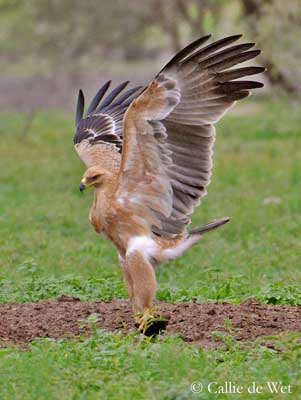
Juvenile is duller, especially on belly, and its plumage is faded and pale, often reddish.
We can find three subspecies:
Aquila rapax vindhiana, from India, Pakistan and Nepal
Aquila rapax belisarius, from North Africa, southern Arabia and Tropical Africa.
Aquila rapax rapax, from sub-Saharan and South Africa.
They differ in size, pattern and rufous colour more or less extended. We find several individual variations.
VOICE: SOUNDS BY XENO-CANTO
Tawny Eagle is usually silent, except during courtship displays or when attacked. During breeding season, it gives a kind of repeated bark “kowk”, similar to corvidae’s call.
HABITAT:
Tawny Eagle prefers desert or semi-desert, steppes with sparse bushes, open savannahs and cultivated areas, from sea level to 2400 metres of elevation, and higher in migration.
It avoids forests and deserts.
RANGE:
In Europe, we find it in extreme east of the continent. In Africa, we find it in south of the Sahara, and some populations breed in North Africa. In Asia, they breed in the central Asia and winter in India and Indochina.
BEHAVIOUR:
Tawny Eagle is resident in numerous places, but we can see some dispersion in strong rain periods, towards more arid areas. Only northern populations are migratory.
During migration and winter, Tawny Eagle is gregarious, include close to a carcass or while feeding in dump. We can often find about twenty birds within a small surface. If there is a food source as swarm of locusts, a big concentration of rats or a flamingo flock, they may be very numerous. It may feed with Vultures too.
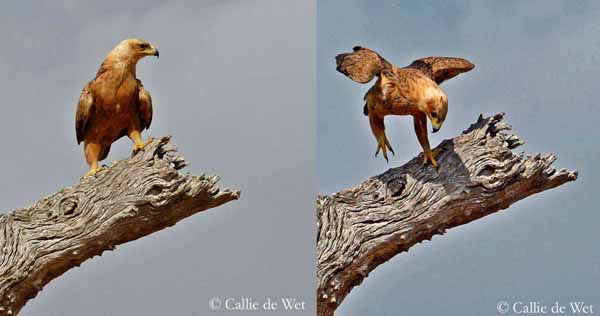
It hunts rather in open areas, swooping down on prey from a perch, or flying down while it is gliding just above its prey, or also walking on the ground.
Young are aggressive when they are three weeks old, if they are threatened at nest. They largely open their bills and spread out their wings, to intimidate the predator.
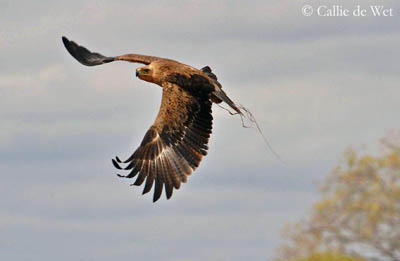
FLIGHT:
Tawny Eagle soars with held wings at body level, or with the hand slightly down curved. When it glides softly, wings are really curved, the hand always downwards. When it flies rapidly, the arm is slightly upwards, and the hand downwards. It has powerful flight. During flight displays, pair performs circles, with slightly undulating flight, or with exaggerated and very deep wing beats.
REPRODUCTION:
Tawny eagle builds a large bulky nest. It is a large platform made with sticks, lined with grasses and green leaves, some paper and bits of plastic. It is situated at the top of a thorny tree, usually Acacia. It is the only African Eagle which does it regularly.
Female lays two white or creamy eggs, speckled with reddish-brown. Incubation lasts about 39 to 44 days, rather by female and short moments by male. Chicks are covered with white down. They have brown eyes, black and yellow bill, and yellow legs.
At about two weeks, first down is replaced by thicker down. At about three weeks, scapulars and coverts appear. At four weeks, feathers grow more quickly. Plumage is complete at about ten weeks of age. Young are fed near the nest, and make some exercises with their wings. They leave the nest when they are about 80 days old, but they still depend of parents for six weeks more. Young may remain with their parents until the next breeding season.
The older chick frequently kills the younger, but fortunately, clutches with two young occur!
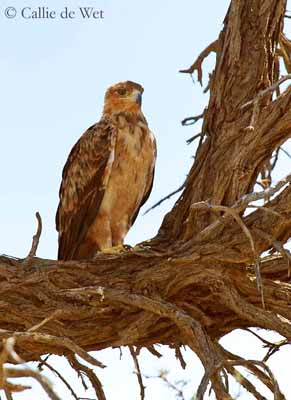
DIET:
Tawny Eagle feeds on all kinds of carrion, usually fresh, often killed by other raptors. It also consumes small mammals as rabbits, small and medium-sized rodents, lizards and snakes. Crickets, grasshoppers and flying termites are eaten, according to the season. They also feed on birds of guinea-fowl’s size, injured or sick individuals.
They also may steal food to other raptors, smaller or larger than them. Tawny Eagle kills its own prey on the ground.
PROTECTION / THREATS / STATUS:
Tawny Eagle African populations have decreased, with direct predation, poison, and traps. But at this moment, world populations are not globally threatened.
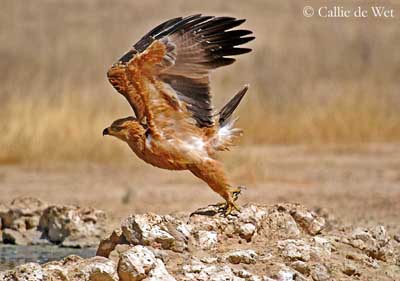
Fr: Aigle ravisseur
All : Raubadler
Esp : Águila Rapaz
Ital: Aquila rapace
Nd: Steppearend
Russe: Степной орел
Sd: Savannörn
Photographs by Callie de Wet
GALLERY
Text by Nicole Bouglouan
Sources:
HANDBOOK OF THE BIRDS OF THE WORLD Vol 2 by Josep del Hoyo-Andrew Elliot-Jordi Sargatal - Lynx Edicions - ISBN: 8487334156
BIRDS OF AFRICA SOUTH OF THE SAHARA by Ian Sinclair and Peter Ryan - Princeton University Press Princeton and Oxford - ISBN: 0691118159
GUIDE DES RAPACES DIURNES – Europe, Afrique du Nord et Moyen-Orient de Benny Génsbol – Delachaux et Niestlé – ISBN : 2603013270
BIRDS OF PREY OF AFRICA AND ITS ISLANDS by Alan and Meg Kemp - Struik Publishers - ISBN: 1770073698
The Hawk Conservancy Trust (Hilary Smith)
Wikipedia (Wikipedia, The Free Encyclopedia)